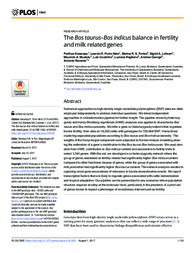The Bos taurus-Bos indicus balance in fertility and milk related genes.
The Bos taurus-Bos indicus balance in fertility and milk related genes.
Autoria: KASARAPU, P.; PORTO-NETO, L. R.; FORTES, M. R. S.; LEHNERT, S. A.; MUDADU, M. de A.; COUTINHO, L.; REGITANO, L. C. de A.; GEORGE, A.; REVERTER, A.
Resumo: Numerical approaches to high-density single nucleotide polymorphism (SNP) data are often employed independently to address individual questions. We linked independent approaches in a bioinformatics pipeline for further insight. The pipeline driven by heterozygosity and Hardy-Weinberg equilibrium (HWE) analyses was applied to characterize Bos taurus and Bos indicus ancestry. We infer a gene co-heterozygosity network that regulates bovine fertility, from data on 18,363 cattle with genotypes for 729,068 SNP. Hierarchical clustering separated populations according to Bos taurus and Bos indicus ancestry. The weights of the first principal component were subjected to Normal mixture modelling allowing the estimation of a gene's contribution to the Bos taurus-Bos indicus axis. We used deviation from HWE, contribution to Bos indicus content and association to fertility traits to select 1,284 genes. With this set, we developed a co-heterozygosity network where the group of genes annotated as fertility-related had significantly higher Bos indicus content compared to other functional classes of genes, while the group of genes associated with milk production had significantly higher Bos taurus content. The network analysis resulted in capturing novel gene associations of relevance to bovine domestication events. We report transcription factors that are likely to regulate genes associated with cattle domestication and tropical adaptation. Our pipeline can be generalized to any scenarios where population structure requires scrutiny at the molecular level, particularly in the presence of a priori set of genes known to impact a phenotype of evolutionary interest such as fertility.
Ano de publicação: 2017
Tipo de publicação: Artigo de periódico
Unidade: Embrapa Agricultura Digital
Observações
1 - Por padrão são exibidas publicações dos últimos 20 anos. Para encontrar publicações mais antigas, configure o filtro ano de publicação, colocando o ano a partir do qual você deseja encontrar publicações. O filtro está na coluna da esquerda na busca acima.
2 - Para ler algumas publicações da Embrapa (apenas as que estão em formato ePub), é necessário ter, no celular ou computador, um desses softwares gratuitos. Sistemas Android: Google Play Livros; IOS: iBooks; Windows e Linux: software Calibre.
Acesse outras publicações
Acesse a Base de Dados da Pesquisa Agropecuária (BDPA) para consultar o acervo completo das bibliotecas da Embrapa.

